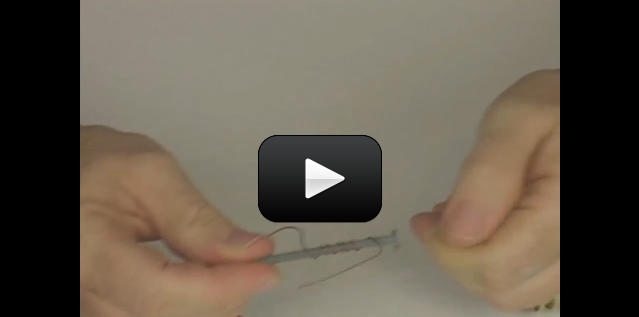After you’ve completed the galvanometer experiment, try this one!
You can wrap wire around an iron core (like a nail), which will intensify the effect and magnetize the nail enough for you to pick up paperclips when it’s hooked up. See how many you can lift!
You can wrap the wire around your nail using a drill or by hand. In the picture to the left, there are two things wrong: you need way more wire than they have wrapped around that nail, and it does not need to be neat and tidy. So grab your spool and wrap as much as you can – the more turns you have around the nail, the stronger the magnet.
(We included this picture because there are so many like this in text books, and it’s quite misleading! This image is supposed to represent the thing you’re going to build, not be an actual photo of the finished product.)
Find these materials:
- Batteries in a battery holder with alligator clip wires
- A nail that can be picked up by a magnet
- At least 3 feet of insulated wire (magnet wire works best but others will work okay)
- Paper Clips
- Masking Tape
- Compass
[am4show have=’p8;p9;p11;p38;p92;p21;p48;p106;p77;’ guest_error=’Guest error message’ user_error=’User error message’ ]
1. Take your wire and remove about an inch of insulation from both ends. (Use sandpaper if you’re using magnet wire.)
2. Wrap your wire many, many times around the nail. The more times you wrap the wire, the stronger the electromagnet will be. Be sure to always wrap in the same direction. If you start wrapping clockwise, for example, be sure to keep wrapping clockwise.
3. Now connect one end of your wire to one terminal of the battery using an alligator clip (just like we did in the circuits from Unit 10).
4. Lastly, connect the other end of the wire to the other terminal of the battery using a second alligator clip lead to connect the electromagnet wire to the battery wire. This is where the wire may begin to heat up, so be careful.
5. Move your compass around your electromagnet. Does it affect the compass?
6. See if your electromagnet can pick up paper clips.
7. Switch the wires from one terminal of the battery to the other. Electricity is now moving in the opposite direction from the direction it was moving in before. Try the compass again. Do you see a change in which end of the nail the north side of the compass points to?
What happened there? By hooking that coil of wire up to the battery, you created an electromagnet. Remember, that moving electrons causes a magnetic field. Well, by connecting the two ends of your wire up to the battery, you caused the electrons in the wire to move through the wire in one direction.
Since many electrons are moving in one direction, you get a magnetic field! The nail helps to focus the field and strengthen it. In fact, if you could see the atoms inside the nail, you would be able to see them turn to align themselves with the magnetic field created by the electrons moving through the wire. You might want to test the nail by itself now that you’ve done the experiment. You may have caused it to become a permanent magnet!
[/am4show]

